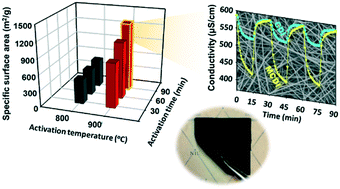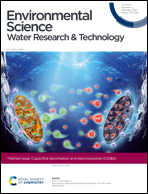Enhanced desalination of electrospun activated carbon fibers with controlled pore structures in the electrosorption process
Abstract
Capacitive deionization (CDI) is a promising ion-separation technology with energy-efficient features for low-salinity desalination. However, the electrosorption capacity limitation is a central challenge due to irregular pore structures and the use of polymer binders in porous carbon electrodes. The aim of this study is to prepare electrospun activated carbon fiber (ACF) webs with well-controlled hierarchical porous structures as high-performance, binder-free electrodes for electrosorption of ions. For characterization of electrospun ACFs, nitrogen adsorption–desorption measurements, Raman spectroscopy, scanning electron microscopy, and cyclic voltammetry tests were carried out. As demonstrated, the electrospun ACFs, prepared from polyacrylonitrile by electrospinning and subsequent oxidation, carbonization, and activation processes with N2/CO2 at 900 °C for 90 min, had a high specific surface area of 1300 m2 g−1 and a 39% increase in mesopores relative to total pore volume. In addition, electrospun ACFs with a high degree of graphitization have good capacitive behaviors for ion storage. As a result of batch-mode CDI experiments at 1.6 V, the electrospun ACFs had a promising electrosorption capacity of 10.53 mg g−1 and good cycling performance. Note that the electrosorption capacity of membrane CDI was three times higher than that of CDI. The significant improvement could be ascribed to the additional interfiber pores, which serve as ion-buffering reservoirs in the electrosorption process. Consequently, by controlling the electrospinning and activation processes without additives, high-performance CDI can be achieved using electrospun ACF electrodes, which have good conductivity and favorable pore structures (e.g., high specific surface area, large pore volume, and enhanced mesoporosity) for the electrosorption of ions.

- This article is part of the themed collections: Environmental Science: Water Research & Technology Cover Art and Capacitive deionisation and electrosorption 2020


 Please wait while we load your content...
Please wait while we load your content...